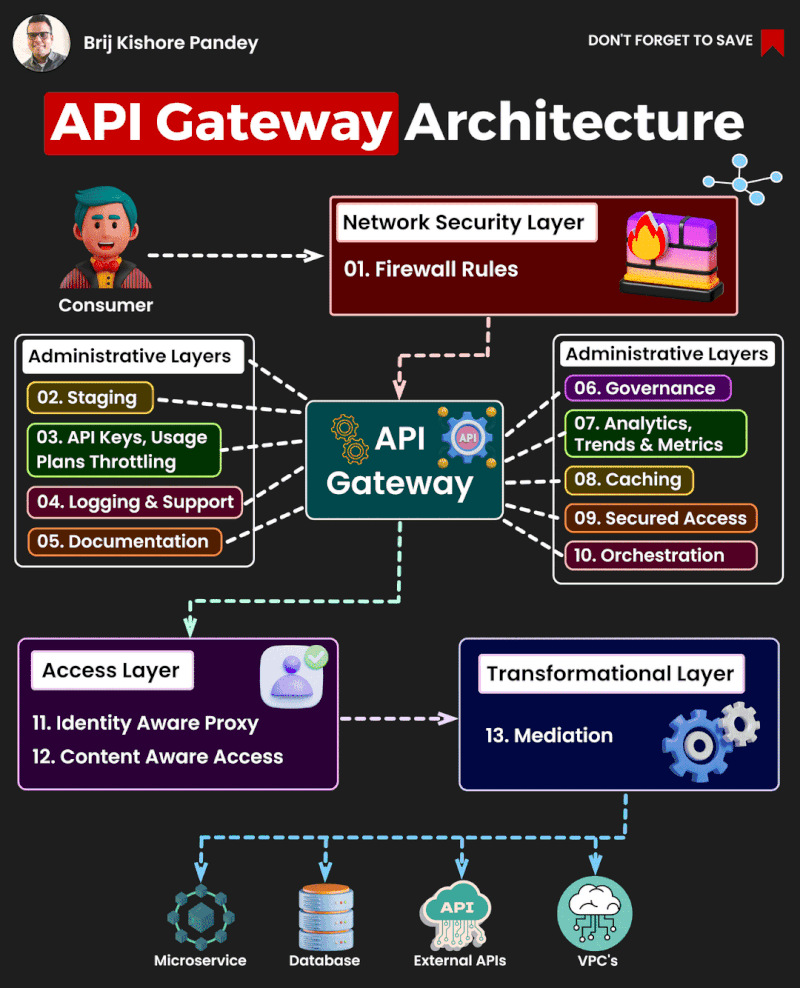
API gateway architecture is a design pattern that uses an API gateway as a single point of entry for all API requests. The API gateway sits in front of the backend microservices and routes requests to the appropriate service. The API gateway can also provide other features, such as authentication, authorization, caching, and monitoring.
API Gateway is a key component in modern microservices architectures that acts as an intermediary layer between client applications and backend services. It provides various functions related to API management, security, routing, and optimization. Below is an overview of API Gateway architecture:
Components of an API Gateway Architecture:
- Client Applications: These are the applications or systems that need to consume services or data provided by the backend services. Client applications make API requests to the API Gateway.
- API Gateway: The API Gateway is the central component of the architecture. It plays several important roles:
- Routing: The API Gateway routes incoming API requests to the appropriate backend services based on URL paths, HTTP methods, or other criteria. It acts as a reverse proxy, forwarding requests to the correct service.
- API Composition: In some cases, an API Gateway may aggregate multiple backend services into a single API endpoint, providing a unified view to clients. This is known as API composition.
- Authentication and Authorization: The API Gateway handles authentication and authorization, ensuring that only authorized users or systems can access certain APIs or endpoints. It may support various authentication methods, such as API keys, OAuth 2.0, or JWT tokens.
- Rate Limiting: To prevent abuse or overuse of APIs, the API Gateway can implement rate limiting and throttling policies, restricting the number of requests a client can make within a certain time frame.
- Caching: Caching can improve API performance by storing responses and serving them to clients without hitting the backend services for every request. The API Gateway can manage caching rules.
- Logging and Analytics: The Gateway logs API requests and responses for monitoring and debugging purposes. It may also provide analytics on API usage and performance.
- Transformation: The API Gateway can transform requests and responses, allowing clients to communicate with backend services using different data formats or protocols.
- Backend Services: These are the microservices or application components that provide the actual functionality or data accessed through the APIs. Backend services receive requests from the API Gateway, process them, and return responses.
- Database and Storage: Backend services may interact with databases, data stores, or other storage systems to retrieve or update data.
Key Features and Functions:
- API Routing: The API Gateway must be capable of mapping incoming requests to the appropriate backend service and route them accordingly.
- Security: It should provide robust security features, including authentication, authorization, and protection against common security threats like SQL injection and cross-site scripting (XSS).
- Rate Limiting: Implementing rate limiting policies to protect backend services from excessive traffic or misuse.
- Caching: Caching responses to reduce the load on backend services and improve API response times.
- Logging and Monitoring: Comprehensive logging and monitoring capabilities to track API usage, detect anomalies, and troubleshoot issues.
- Analytics: Collecting and analyzing data on API usage, performance, and errors to gain insights into the API ecosystem.
- Transformation: The ability to transform requests and responses to bridge the gap between client requirements and backend service interfaces.
- Load Balancing: If multiple instances of a backend service are available, the API Gateway can perform load balancing to distribute requests evenly.
Deployment Options:
API Gateways can be deployed in various ways, including:
- On-Premises: Installed and managed within an organization’s own data center or infrastructure.
- Cloud-Based: Leveraging cloud-based API Gateway services provided by cloud providers like AWS API Gateway, Azure API Management, or Google Cloud Endpoints.
- Containerized: Running as a container within an orchestration platform like Kubernetes.
I’m a DevOps/SRE/DevSecOps/Cloud Expert passionate about sharing knowledge and experiences. I am working at Cotocus. I blog tech insights at DevOps School, travel stories at Holiday Landmark, stock market tips at Stocks Mantra, health and fitness guidance at My Medic Plus, product reviews at I reviewed , and SEO strategies at Wizbrand.
Please find my social handles as below;
Rajesh Kumar Personal Website
Rajesh Kumar at YOUTUBE
Rajesh Kumar at INSTAGRAM
Rajesh Kumar at X
Rajesh Kumar at FACEBOOK
Rajesh Kumar at LINKEDIN
Rajesh Kumar at PINTEREST
Rajesh Kumar at QUORA
Rajesh Kumar at WIZBRAND

 Starting: 1st of Every Month
Starting: 1st of Every Month  +91 8409492687
+91 8409492687  Contact@DevOpsSchool.com
Contact@DevOpsSchool.com
